Our Blog On-Demand
Content
Knowledge Hub
Knowledge Hub
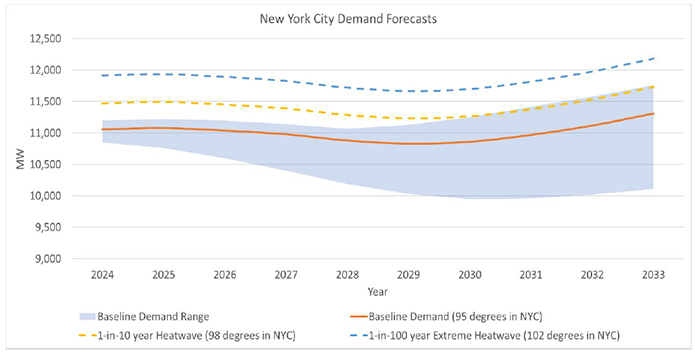
Photo Credit: New York Independent System Operator
A summer like this year’s could be trouble for New York City in 2025.
Earth’s hottest summer on record lingered into early September in the Big Apple, as the city posted its first official heatwave of the year with three consecutive days of high temperatures exceeding 90 degrees Fahrenheit.
Should the summer two years hence also be especially hot, New York City could grapple with blackouts or brownouts. The New York Independent System Operator (NYISO) has projected a deficit of as much as 446 MW on the peak day during expected weather conditions (95 degrees Fahrenheit).
The baseline summer coincident peak demand forecast for New York City (Zone J) in 2025 increased by 294 MW in the past year, primarily due to the increasing electrification of transportation and buildings, NYISO noted, in identifying a “reliability need” in its Q2 Short-Term Assessment of Reliability (STAR).
Also, NYISO noted, as of May 1, 2023, 1,027 MW of affected peak generation plants have deactivated or limited their operations under the New York State Department of Environmental Conservation’s (DEC’s) “Peaker Rule,” which provides for a phased reduction in emission limits, in 2023 and 2025, during the ozone season (May 1-September 30). An additional 590 MW of peakers are expected to become unavailable for summer 2025, all of which are in New York City, thereby resulting in a total unavailability of 1,617 MW of peaker generation capability.
In terms of possible relief, the DEC regulations include a provision to allow an affected generator to continue to operate for up to two years, with a possible further two-year extension, after the compliance deadline if the generator is designated by the NYISO or by the local transmission owner as needed to resolve a reliability need until a permanent solution is in place. So, at least some of the peaker generation capacity that is currently expected to be unavailable could instead remain available through a two-year extension, and an additional two years thereafter if an additional extension were granted, thus perhaps mitigating the near-term reliability need for New York City.
Also, “The New York City transmission security margin is expected to improve in 2026 if the Champlain Hudson Power Express (CHPE) connection from Hydro Quebec to New York City enters service on schedule in spring 2026, but the margin gradually erodes through time thereafter as expected demand for electricity grows,” according to NYISO’s STAR report.
Looking beyond 2025, NYISO warned that the forecasted reliability margins within New York City may not be sufficient if the opening of the CHPE, which will deliver 1,250 MW of renewable power into the New York metro area, is significantly delayed. Reliability margins also may not be sufficient if additional power plants become unavailable or demand significantly exceeds current forecasts, NYISO noted.
“Without the CHPE project in service or other offsetting changes or solutions, the reliability margins continue to be deficient for the ten-year planning horizon. In addition, while CHPE is expected to contribute to reliability in the summer, the facility is not expected to provide any capacity in the winter,” according to NYISO.
In the meantime, Con Edison, as the Responsible Transmission Owner, is solely responsible for developing a regulated solution to the near-term reliability need that NYISO has identified for summer 2025. NYISO has also solicited market-based solutions.
Per NYISO: “If proposed regulated or market-based solutions are not viable or sufficient to meet the identified reliability need, interim solutions must be in place to keep the grid reliable. One potential outcome could include relying on generators that are subject to the DEC’s Peaker Rule to remain in operation until a permanent solution is in place.”
A reliability need could also drive up capacity prices for New York City in summer 2025, if the possible conditions that NYISO has warned could be created by a combination of escalating demand and the retirement of generators come to fruition.
As this is an emerging and evolving situation, CPower will follow it closely. If you have immediate questions or would like information in the meantime, please contact us online or at 844-276-9371.
Keith Black
As CPower’s Regional Vice President and General Manager for the Northeast, Keith has leveraged his unique combination of sales and operations expertise, energy business relationship development, channel development, sales opportunity identification and solutions management, backed by his intrinsic talent for building winning business strategies, to help the company and its customers achieve strong and sustainable financial gains.
In leading CPower’s business and growth strategy for New England and New York, he has helped in expanding New England’s leading edge of solar, storage, and residential monetization and capturing market share in all aspects of the evolving DER landscape in New York. Succeeding in these exciting and cutting-edge DER opportunities has come with a complex array of technologies, controls and partner integrations, as well as a demanding and high touch for his team.
A versatile, high-energy executive, he has extensive experience in leading high-performing teams, at businesses from Fortune 500 organizations through start-ups, and guiding companies to profitable growth. With more than 30 years of experience in the energy industry, he has become a trusted energy advisor to both prospects and customers, enabling them to reduce risk, lower costs and use renewable resources when possible.

Recently released research shows that mounting reliability risks make demand response (DR) increasingly important as the grid transforms. An aging grid dominated by solar and wind power, battered by storms and fires and struggling to supply new needs like EVs and electric heat pumps, needs the flexibility that DR provides.
“Paradigms for the generation and delivery of electricity are evolving away from a centralized network with predictable power flows toward a distributed and dynamic grid, creating many challenges and opportunities for utilities and other entities involved in the electricity value chain,” according to a new report about grid reliability challenges published by Wood Mackenzie and CPower. “At the heart of these changes is how reliability is assured when the grid is most stressed, like when customer demand peaks during heat waves, natural disasters or extreme weather events.”
Based on insights from analysts at Wood Mackenzie, the report shows that DR programs have proven to be an important resource for ensuring reliability amidst grid challenges in the past, but that such support may not always be available. Analysts explain how low capacity pricing and cumbersome rules on DR participation threaten the future of DR programs and the ability to use distributed energy resources (DERs) to help the grid.
If energy users were to stop participating in DR, analysts note, utilities and grid operators would lose their most reliable resource during emergencies as well as a resource that can provide much-needed flexibility year-round.
Such year-round flexibility is imperative because the proliferation of intermittent renewable resources, the retirement of fossil-fuel generators, and the electrification of vehicles, heating and other key energy needs are straining the grid, making it difficult to balance supply and demand.
“As the grid’s needs continue to evolve, particularly with the growth of other types of distributed energy resources (DERs) besides DR, such as solar generation, battery storage, and electric vehicles, DR is an increasingly important part of the resource stack in energy markets,” according to the report from Wood Mackenzie and CPower.
The North American Reliability Corp. recently issued a similar warning about the importance of flexibility in mitigating risks to grid reliability.
“System operators and planners should ensure that sufficiently flexible ramping/balancing capacity is available to meet the needs of changing patterns of variability and new characteristics of system performance. In future decades, growing storage and demand-side flexibility may help mitigate the concerns for flexibility and attention will turn to multi-day energy concerns, but intraday flexibility remains important during this transition,” according to NERC’s 2023 Electric Reliability Organization (ERO) Reliability Risks Priorities Report.
Today’s tech-enabled DR can play a key role in energy, ancillary services and other flexibility markets. But policymakers must eliminate barriers like unsustainably low pricing and unworkable administrative complexities to unlock the full flexibility of DERs, according to Wood Mackenzie and CPower’s report. To do so, the paper’s authors suggest market reforms such as revising compensation methods for DR resources, fixing capacity accreditation and introducing a price floor for DR.
If you would like to learn more about the research and recommendations from Wood Mackenzie and CPower, you can download a copy of the report here: Ensuring Grid Reliability with DERs.
Kenneth Schisler
Ken leads CPower’s regulatory and government affairs team, having previously served in similar roles at both Vicinity Energy and EnerNOC/Enel. He brings nearly three decades of policy leadership on innovation in clean and advanced energy technologies and collaborates with public officials, regulators, power exchange and system operators, academia and industry peers to unleash the potential of demand-side resources.

Securing funding and structuring a contract may be the hardest parts of developing new distributed energy resource (DER) projects.
Even with the Inflation Reduction Act set to catalyze billions of dollars of investment in renewable energy projects, financial viability – or the perceived lack thereof – has become a bigger barrier to deployment than technology. In a recent survey, microgrid developers ranked funding approval as the most challenging project stage, followed by project sizing and capturing upside monetization opportunities.
Getting DER projects greenlighted can be challenging because proformas often do not reflect the full value of the investment, or financiers discount project return projections because the tools utilized to estimate returns are not employed to realize value in live operations. Many times, DER owners and developers overlook opportunities to earn grid services revenue or reduce costs or do not realize projects can recognize both. Full visibility into a project’s value stack is essential to both funding and contracting DER projects.
DERs are any assets that use, store, discharge, or generate electricity, like on-site generation, energy storage, electric vehicle chargers, solar panels, or load curtailment. Energy users are installing more DERs but only when they can make the projects pencil financially by connecting them to sufficient value.
Optimizing DERs involves choosing between all available value streams in each day or hour based on which would be most lucrative, and stream values can differ substantially depending on the details of the site and project. Successful DER projects justify investments by creating proformas that account for all possible revenue and savings based on the site and asset constraints and the available value opportunities.
If you are a DER owner/operator trying to fund a project, optimization starts at the proposal stage to enable an accurate view of all the on-bill and grid services value and ensure the asset is sized to optimize that value. Beginning at the proposal stage helps in sizing projects correctly and making even marginal projects pencil by considering all available value streams. Calculating the returns that a project would yield and demonstrating where they will come from and how they will be realized improves your chances of securing financing.
In structuring your proposal and contracting structure for behind-the-meter projects, identifying the type of value and timing of realization of that value can be key to identifying creative contracting structures with the utility-account-holder. For example, monthly or annual lease payments from the utility-account-holder may be possible where on-bill value is the driving value source, or a split of grid service revenue may be a more reasonable approach where grid services are key to the project’s financial health. Identifying and executing on the ideal contract structures stems from a high degree of confidence in what sources of value will be realized post-contract.
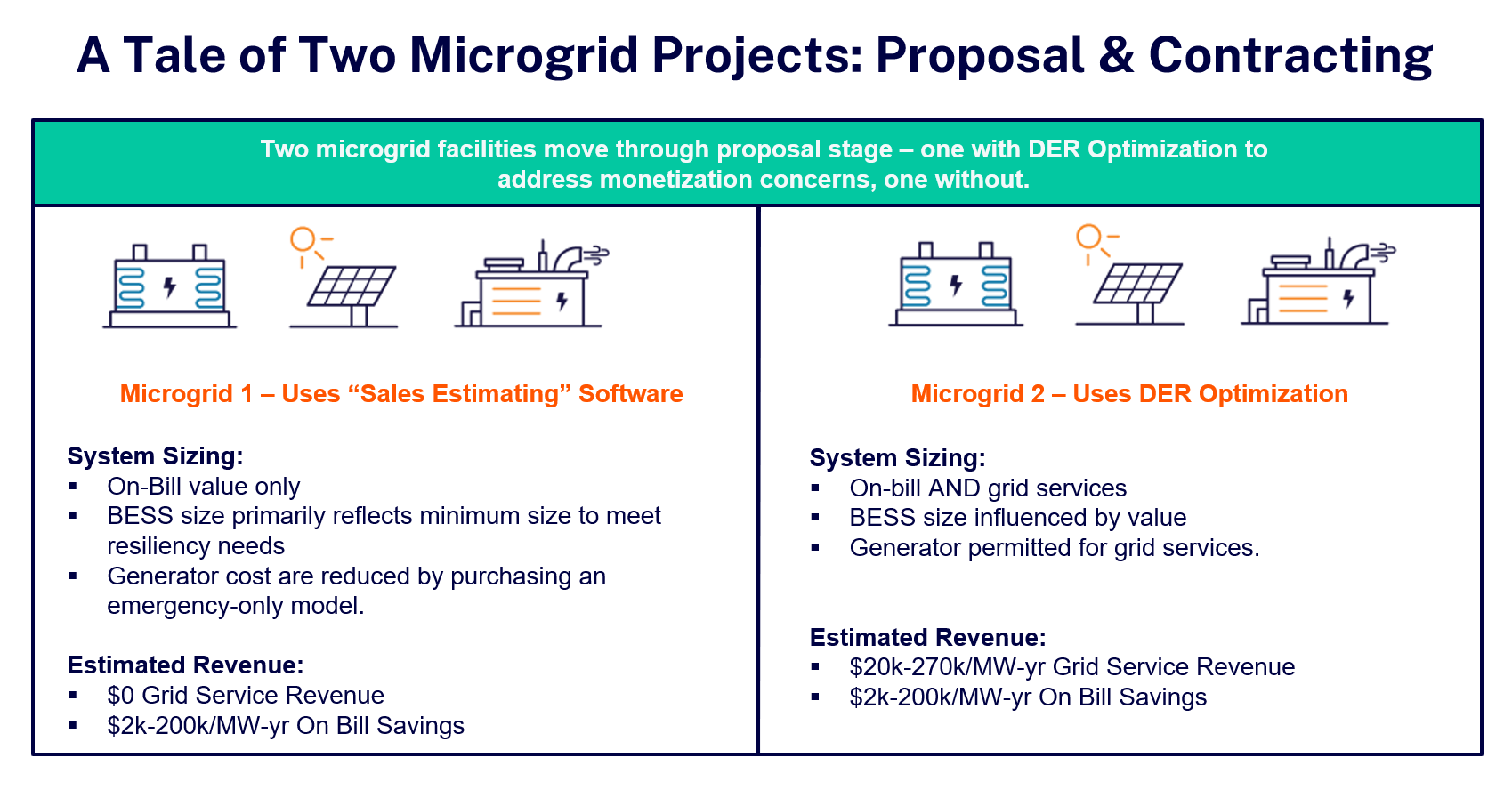
Overlooking opportunities at the outset can prevent a customer from accepting your proposal or limit the project’s eventual returns. Consider the returns from two DER projects in ISO New England (ISONE) as examples. One project used DER optimization but the other did not.
This customer developed a microgrid based on the energy user’s resiliency requirements and demand charge management expectations only. Although the project was approved and eventually met the customer’s requirements and expectations, it could have been more rewarding with a larger battery that would have provided incremental resiliency. The customer ultimately left money on the table because it did not consider the full stack of available value streams, and participation in other available programs such as ISONE capacity programs and Connected Solutions was suboptimal.
The participation of the generator was also limited by the lack of DER optimization. The customer invested in a generator that was permitted for emergency-use only and was specifically to address their resiliency requirements. With a DER optimization view and a full picture of all sources of potential value, the customer may have found that they could have contracted instead for a non-emergency-only generator and used that generator for both the resiliency requirements and to earn revenue by providing grid services. The revenue earned from grid services would have more than offset the added cost of a properly permitted non-emergency generator.
Conversely, another customer and benefited more from their project by considering all value streams and the full potential of DER optimization when designing, funding, and contracting their project. Beginning at the conceptual stage, they iterated on key aspects of the battery for a retrofit to a solar array in the PJM area.
Duration was one of the elements evaluated when modelling potential grid services values in PJM. After considering several duration iterations, the project developer decided that a one-hour battery would provide better returns than a multi-hour battery based on anticipated value streams, cost considerations, and warranty constraints. As a result of determining the right size for the battery upfront, the customer increased its projected return and is now set up to take advantage of all revenue streams.
Such potential to benefit from multiple revenue streams is always helpful given that the financiers of DER projects want as many revenue sources as possible. Diversification of project revenue sources and greater returns increase the chances of securing funding.
Securing funding for DER projects may be hard, but DER optimization makes it easier. Considering and pursuing all value streams from the beginning helps projects pencil and increases returns.
If you would like to learn more about why energy users and DER portfolio owners are turning to optimization solutions that evaluate site-specific performance data and energy market options to create project proformas that get projects greenlighted, watch our presentation from the 2023 Microgrid Knowledge conference: The Greatest Bang for Your Buck: Getting Projects Contracted and Funded with DER-Asset Optimization.
You can also call us at 844-276-9371 or visit CPowerEnergy.com/contact to find out how our EnerWise™ Site Optimization solution makes estimating and delivering the value of DER projects easier.
Rob Windle
As CPower’s Vice President, Strategy Planning & Business Development, Rob keeps a curious eye locked on the future. He leads the development and management of innovative solutions that support the proliferation and monetization of distributed energy resources (DERs) such as decentralized generation and energy storage. He has more than 20 years of experience in product development, direct and channel sales development, and management across the Energy, Enterprise Software, and Automation Controls industries. A Certified Energy Manager®, he holds a Bachelor of Science degree in industrial engineering from the University of Cincinnati and lives in Atlanta, Georgia.
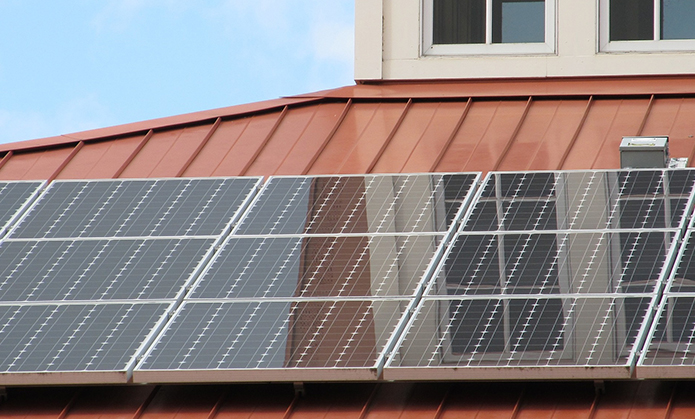
Credit: Renewable Energy World (A rooftop solar system)
*This article first appeared on Renewable Energy World on July 28, 2023. Click here to view.
Strained by the double burden of increased demand and more frequent extreme weather events, our grid struggles to provide reliable electricity in many areas of the country – and the challenge will only intensify in the years to come.
The related search for reliable expanded grid capacity has generated buzz about a relatively new term for a solution that has been around for some time: Virtual Power Plants (VPPs). These networks aggregate electricity from customer-owned distributed energy resources (DERs) such as batteries, building management systems, smart home devices, and electric vehicle chargers, then use these assets to help keep the grid balanced by reducing or shifting energy use.
While the term VPP is relatively new, large energy users have been called on to reduce power consumption during times of peak demand for decades. What’s new is the technology advancements enabling greater sophistication and automation, and the exponentially growing base of DERs that can be tapped to expand grid capacity without costly new plants or infrastructure projects. Anything connected to the grid that generates or consumes energy and can respond to a signal can efficiently support grid reliability through VPPs: rooftop solar, smart thermostats, smart water heaters, EV chargers, and more.
A growing body of research has shown that VPPs provide resource adequacy and environmental benefits at a significantly lower price point than other options, such as gas peaker plants and grid-scale battery storage. For instance, a recent Brattle Group study, “Real Reliability: The Value of Virtual Power,” found numerous economic and societal benefits from VPPs. Most notably, the study found that the net cost of VPPs is 40% lower than that of a gas peaker plant, and 60% less than a utility-scale battery storage system. According to the study, VPPs ultimately provide cost savings of $15 billion to $35 billion compared to the alternatives.
Meanwhile, customers enjoy an additional $20 billion in societal benefits over 10 years: faster grid connection, decreased greenhouse gas emissions, increased use of renewable energy, expanded grid capacity for electrification, and greater customer satisfaction. In fact, the study showed that VPPs were the only resource for which societal benefits exceeded cost.
While the benefits of VPPs may seem abstract to the average energy user, VPPs have a very real impact on maintaining energy reliability and customer well-being as extreme weather events become more frequent and severe. For example, a CPower VPP provided more than 50 GWh of load relief during Winter Storm Elliott last December, an amount of energy equivalent to the daily energy use of more than 1.7 million homes, helping grid operators to prevent further blackouts as they managed the impacts of unplanned natural gas generation failures.
VPPs are ready to conquer grid capacity and resiliency challenges faster, more sustainably, and more cost-effectively than ever before – but only if our regulatory frameworks let them.
In many areas, VPP adoption has been hindered by power market regulations that preceded the rise of VPP-compatible technologies. Updating these regulations and resolving questions about how to adequately value these resources and incorporate them into regulatory frameworks would allow customers to play a more active role in cost-effectively managing and optimizing the use of energy resources for greater energy resilience.
What we need now is for regulators and stakeholders to work together on policy, regulatory, and market-based solutions to accelerate the large-scale adoption of VPPs. Regulators can consider modifications to market participation rules that recognize the capacity benefits that VPPs provide to the grid.
One step could be to make it easier for customers to share their data, needed to estimate earnings, monitor performance and finalize payments, with VPP providers. Other solutions include easing aggregation limitations and widening eligibility requirements to reflect the wider spectrum of grid-connected assets available today and updating pricing structures and compensation mechanisms to adequately incentivize VPPs for both DER-owning customers and utilities. Such collaboration between regulators, stakeholders, and customers is the key to achieving a more distributed, flexible, cost-effective, and resilient energy grid.
As the demands of electrification and extreme weather strain the grid, we don’t have to wait to build capacity: we already have the technology and resources to deploy 60 GW of VPPs by 2030, which would meet future resource adequacy needs. VPPs are already helping utilities power through months of heat waves and increased demand—and they could do much more. Regulators can unlock the full potential of VPPs to reduce costs and greenhouse gas emissions while ensuring grid stability when we need it most.
Mathew Sachs is Senior Vice President of Strategic Planning and Business Development at CPower Energy, a national DER monetization and Virtual Power Plant provider.

New CPower CEO Mike Smith may have backed into the energy industry, but he has since helped move it forward. In his more than 25 years in the sector, he has developed a reputation for driving growth and delivering innovation at some of energy’s leading companies.
Now at the helm of the nation’s largest provider of distributed energy resource (DER) monetization opportunities and virtual power plants, Smith is set to guide CPower, its customers and the grid into the future.
“I am thrilled to be joining the team at CPower, a company whose work is essential in ensuring a successful and reliable new energy economy,” Smith stated when CPower announced that he would be CEO following the retirement of previous CEO John Horton.
“The company has a strong foundation and is well-positioned to capitalize on the tremendous opportunities in the rapidly evolving distributed energy space,” Smith continued.
Most recently the CEO of solar and battery storage developer ForeFront Power, Smith discussed his career as a DER and utility leader, his vision of the industry’s future and his expectations for how CPower and its customers will help enable the transition in an interview with The Current.
The Current: How did you get into the energy industry? And why?
Smith: I got into the energy industry very much by accident. I was practicing law in a law firm in Columbus, Ohio, minding my own business as a trial lawyer, and I was in this period of career growth that I call improv. What I mean by improv is that the answer to every question is, “Yes.”
A partner came up to me one day and said, “We’ve got this new client and they’re in a dispute over natural gas trading in the state of West Virginia. Two of their employees are being deposed in this dispute and they need a lawyer to sit with them during the deposition. Would you do it?” And I said, “Sure. Why not?”
It turns out the client was a then little-known company from Houston called Enron. The two guys who were in this dispute weren’t accused of anything, but they needed to be deposed. So, I sat with them in their depositions.
Then Enron, which had a small office in Columbus, decided they wanted to have permanent counsel in the area, and as part of that wanted to have a lawyer be seconded to their Ohio office to learn natural gas trading. Once again, the law firm came to me and said, “Do you want to work with this natural gas trading company called Enron to learn how to do natural gas contracts?” And, again, I said, “Sure. Why not?” So, I ended up working for Enron as a secondment.
The Current: How has the industry evolved during your career?
Smith: In some ways, it hasn’t changed at all. What I mean by that is, yes, we brought in retail choice, and I saw that happen. But the physicality of the electric grid hasn’t changed a bit. We still make most of our electrons in large central-station power generation and put them into a copper wire and sell those electrons to end-use customers.
What we’re seeing now though, is that the physicality is changing. More and more customers are generating more of their energy instead of buying it from the grid. Also, more and more customers are seeking to reduce energy consumption through energy efficiency programs and many more customers are installing energy storage. So, we’re seeing monumental change in the physicality of the grid and how customers interact with the grid, which I think is what’s exciting about what we’re doing here at CPower.
The Current: What attracted you to the role of CEO at CPower?
Smith: We’ve got a whole industry that’s doing things like building on-site solar generation, building on-site storage and doing other DER projects. That’s all going to continue to happen. CPower sits at this unique position in between those end-use customers that have responsive assets, whether they be load, generation or storage, and the grid, which needs access to those responsive assets. We provide a unique and valuable service sitting in the middle. That’s what attracted me to CPower—being at the number one player, with the best team, in the most exciting piece of the energy industry.
The Current: What do you see as some of the most exciting innovations happening in the energy industry to meet the changing needs and demands of customers and the grid?
Smith: The deployment of energy storage is a big piece of that continued penetration of on-site generation assets, particularly solar but also fuel cells. Again, it’s this theme of more and more customers taking control of their energy production and consumption. This is the most exciting thing. Then, of course, we can use CPower to optimize those assets and provide essential grid reliability services in times when the grids are going to be continually more and more stressed with extreme weather events.
The Current: What does the future of the grid look like?
Smith: It’s going to be an evolution. We’re going to continue to have central-station generation, which will be a combination of nuclear and some kind of fossil fleet, including natural gas, and grid-connected renewables. But more and more, the grid will continue to be decentralized and more resources pushed to the edges of the grid in terms of customer-site generation and storage. That trend will continue for the foreseeable future.
The Current: What role will energy users play in the future?
Smith: Energy users will continue to become a much larger part of the equation as they have opportunities to install on-site generation and storage. We also can’t forget about the fact that the fueling of vehicular fleets will move more to the customer as more and more of our customers electrify the fleets that they own. Customers who shop at their places of business or work at their places of business will be seeking to charge their EVs as well. That’s a whole new piece of the infrastructure puzzle that adds demand and that flexibility needs to be well-managed to have a well-functioning grid.
Also, customers who are controlling their energy costs or are on a sustainability journey are becoming more sensitive to what they’re paying and the source of the energy they’re using. That’s driving a lot of the things that CPower can get involved in both in terms of not just responsive load assets, but also optimizing on-site generation and storage.
The Current: What are your biggest priorities for CPower?
Smith: First and foremost, our focus on the customer is a core company value, and that won’t change. CPower will also continue to do the great things we’ve done to bring the company to where it is now. That is to protect, preserve and expand our legacy capacity demand response business where we can, and then build additional flexibility programs that allow us to provide more DER or asset optimization services for more customers nationwide.
The Current: What else do you want customers to know about you and CPower?
Smith: Customers need to know that we can give them valuable ways to monetize their assets. Every customer that has a building has a load asset that has value. We can help them determine that value and extract that value from the market. And, if you add on to that on-site generation assets or storage assets, that provides even more untapped opportunity for these customers.
To learn more about DER monetization and how CPower can help you monetize your energy assets while supporting sustainability, improving grid reliability and increasing energy resiliency, call us at 844-276-9371 or visit CPowerEnergy.com/contact.
Mike Smith
Mike Smith is a visionary and innovative leader who brings more than 25 years leadership experience in the energy industry to CPower as its CEO. Mike joined CPower from ForeFront Power, where he was the CEO of the company’s North American solar and energy storage business, responsible for strategy and all business areas across the U.S. and Mexico.
Prior, Mike served as Senior Vice President, Distributed Energy, at Constellation, the retail energy subsidiary of Exelon Corp., where he was responsible for Constellation’s distributed solar, energy efficiency, and energy asset operations businesses across the U.S. He also served as Vice President, Innovation and Strategy Development, for Exelon Generation, and led Constellation Technology Ventures, Exelon’s venture investing organization. Earlier, Mike was Vice President and Assistant General Counsel for Enron Energy Services and a trial lawyer at Bricker & Eckler, LLP.
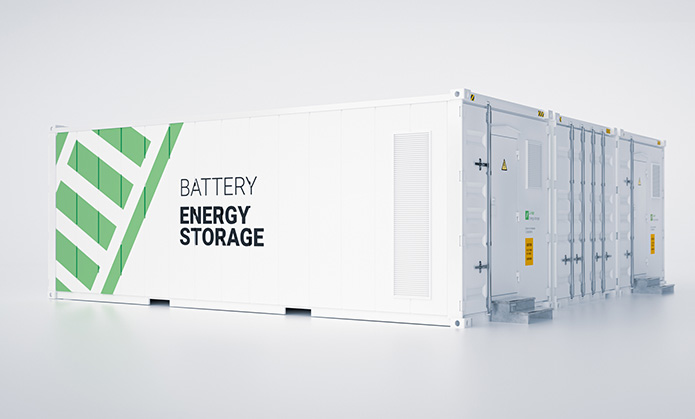
Connecticut is at the forefront of the energy storage movement and CPower leads the way in helping customers deploy more batteries.
The state recently recognized CPower as an early adopter of energy storage solutions by giving the company a Green Bank Award. CPower was one of the first Eligible Contractors to submit a storage project to Energy Storage Solutions, which offers incentives to reduce the cost of energy storage systems. The program is overseen by the Public Utilities Regulatory Authority (PURA), is paid for by electric ratepayers, and is administered by the Green Bank, Eversource and United Illuminating.
CPower was awarded almost 40 MW of battery systems for the first tranche of the program, in which a total of 50 MW was awarded. The company has also submitted additional projects for the next stage of the program to help the state meet its energy storage goals.
The second tranche of awards will include up to 100 MW in projects and is accepting applications today. Recognizing the benefits that energy storage has provided for customers and the state, CPower supports efforts to accelerate the awarding of incentives in the next stage of the Energy Storage Solutions program so that batteries spread across Connecticut faster.
Incentives in New England states such as Connecticut help organizations reach their sustainability goals while improving facility resiliency and decreasing operations, maintenance and energy expenses. For example, Connecticut’s Energy Storage Solutions program offers organizations upfront incentives for installed battery capacity plus performance-based incentives for dispatching the battery capacity to the grid. In doing so, the statewide battery program fosters a more reliable and resilient electric distribution system, especially for vulnerable communities.
Commercial and industrial building owners can save money through the Energy Solutions Program by using batteries to reduce peak demand management charges. Incentives for C&I building owners include:
As an example, a healthcare facility in Connecticut projected $186,000 in on-bill savings in the first year after installing a battery through CPower. Importantly, these on-bill savings are in addition to the performance incentives paid by utilities and grid operators.
CPower has the largest dollar amount of C&I projects in the Energy Storage Solutions queue in Connecticut. It also leads all contractors in C&I projects underway. All told, CPower has more than 100 MW of C&I battery projects in the design phase across New England.
CPower provides OnDemand Energy Storage solutions for customers in Connecticut, Rhode Island and Massachusetts. In working with CPower as an energy-storage-as-a-service (ESaaS) provider, New England facilities can reap energy storage benefits such as on-bill savings and grid services revenue without the upfront costs or responsibilities of ownership.
CPower will design, install and operate a battery on an organization’s behalf — and cover all upfront costs, thereby allowing C&I customers to avoid the interconnection engineering, capital investment and O&M responsibilities associated with a battery project.
Energy Storage Solutions projects done by CPower provide customers in Connecticut with a path to more affordable, resilient and greener energy.
To learn more about CPower’s energy storage services, call us at 844-276-9371 or visit CPowerEnergy.com/contact.
Philip Ciulla
As Account Executive for New England for CPower, customers and team members alike look to Phil as a knowledgeable and trusted partner. For Phil, the feeling is definitely mutual. Born and raised in California, Phil now lives in New England.
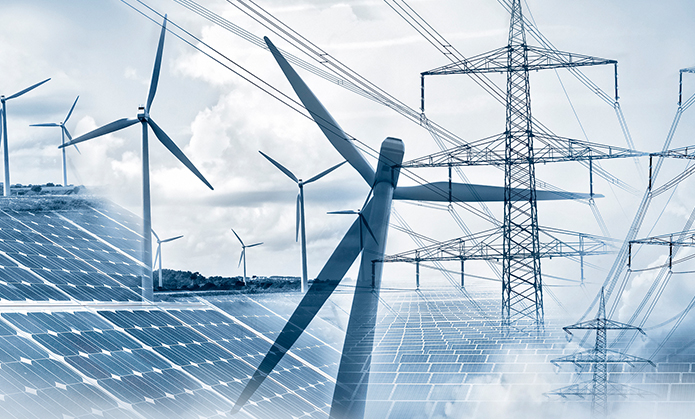
When the grid is stressed, would you rather turn on a fossil-fuel-powered peaker plant or tap into existing resources to reduce our electricity consumption? For us, it’s a simple choice for the community and our planet.
The Customer-Powered Grid™ is the answer. In aggregating customers’ distributed energy resources (DERs) and collectively using them to help the grid when and where it’s needed the most, we can create a flexible, clean and dependable future.
Peaker plants are major emitters of greenhouse gases and have a negative impact on air quality and public health. By leveraging DERs that are already available, like demand response, we can help reduce carbon emissions and other pollutants to help mitigate the impacts of climate change.
DERs Counter Climate Change Impact
Customers recognize the potential of DERs, which are assets or devices that consume, store or generate power and can respond to a signal, as well. Sustainability is the second-most-common reason for implementing DERs, with one in three customers citing it as a motivation, according to CPower’s 2023 Customer-Powered Grid Survey.
The grid needs more clean energy, which DERs can supply reliably and affordably, and that need for flexibility is growing:
We won’t be able to ensure grid stability through this rapid transition and beyond without DERs. DERs such as demand response and energy efficiency support greater deployments of clean, renewable energy resources by filling gaps in variable generation. Given their flexibility, DERs can quickly respond to changing grid needs at any time, like if renewable generation unexpectedly drops due to a decrease in the availability of sun, wind or gas.
DERs also reduce the need to build new generation capacity, which is crucial because we must quickly replace coal-fired power plants like the peaker plants that have historically provided flexibility to the grid. The U.S. is on track to close half of its coal generation capacity by 2026 and cut coal consumption by the power sector in half by 2030, all of which could affect the stability of the grid.

CPower envisions a flexible, clean and dependable energy future enabled by The Customer-Powered Grid™.
DER Monetization Supports Sustainability.
Energy users benefit from investing in DERs and by monetizing them through grid services. More than 88% of CPower customers say that DER Monetization has helped their business. In addition to saving money by curtailing their loads when the grid is stressed, these energy users can take the revenue generated from their participation in wholesale market or utility grid programs to improve or invest in operational or sustainability initiatives for their organization.
Energy users are also under significant pressure to reduce emissions, make ESG investments and counter the impacts of climate change. DER Monetization helps an organization achieve its clean energy goals by allowing it to use less electricity and reduce associated emissions.
We are proud to have helped our customers avoid more than 280,000 metric tons of CO2, equivalent to not burning more than 317 million pounds of coal, in a single year alone. We know that the work we do is essential in making our vision of a flexible, clean and dependable energy future enabled by The Customer-Powered Grid a reality.
This year, we are also supporting sustainability as an organization through our internal initiatives as well as by donating to EarthDay.org, whose mission is to diversify, educate and activate the environmental movement worldwide.
Clean energy commitments by companies — and the pressure others face to keep up — are becoming watershed moments for the energy transition. From technology and manufacturing companies to real estate and big-box retailers, companies are committing to decarbonization.
By investing in clean energy, using less electricity and participating in utility and energy market grid services, energy users can help fill the role now played by gas generators from central systems. That is, why burn fuel to power a peaker plant when you can use DERs to balance the grid when it’s stressed?
The answer is obvious to us. How about you?
Join us on the journey to the Customer-Powered Grid — and the flexible, clean and dependable energy future that it will enable. Call us at 844-276-9371 or visit CPowerEnergy.com/contact to learn how we can help you most effectively invest in DERs to support sustainability, improve grid reliability and increase energy resiliency.
Shelley Schopp
As Senior Vice President, Customer Fulfillment & Human Resources, Shelley leads CPower’s Operations team. With over 25 years of experience in the energy industry, she helps the company share its collective wisdom through every touchpoint CPower offers.
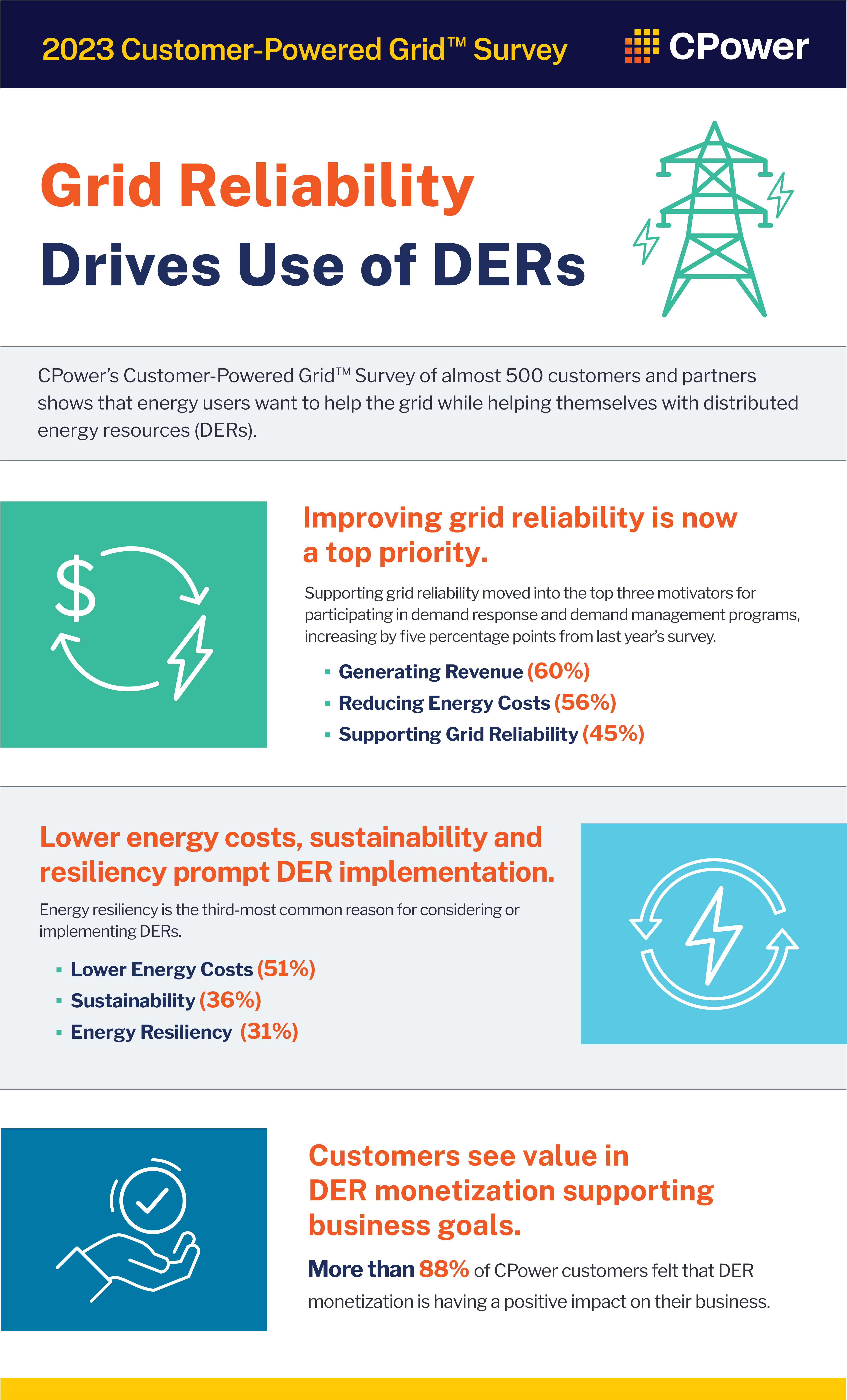
Grid reliability has become one of the primary reasons that energy users participate in distributed energy resources (DER) monetization, ranking among the top three motivators for the first time in CPower’s annual Customer-Powered Grid™ Survey.
Nearly half (45%) of the almost 500 customers and partners surveyed cited supporting grid reliability as motivation for participating in grid services. Only generating revenue (60%) and reducing energy costs (56%) were cited more often.
Energy users worry about grid disruptions and scarcity events caused by factors such as more power outages from extreme weather and shifting demand patterns due to electrification and other issues.
Electricity peak demand and energy growth rates in North America are both increasing, the North American Electric Reliability Corporation warned in its most recent long-term reliability assessment, noting that the 10-year summer and winter peak demand growth projections showed the largest percentage increase in recent years.
Customers can help balance the grid when and where it’s needed the most through grid services programs that pay them for using less electricity when the grid is stressed.
More than 88% of the CPower customers survey confirmed that DER monetization has helped their business as well. Customers often use the revenue generated from their participation in wholesale market or utility grid programs to improve or invest in operational or sustainability initiatives for their organization.
Sustainability was the second largest motivation for implementing DERs (36%), followed by energy resiliency (31%). By using DERs for themselves and monetizing them through grid services, customers can improve operational reliability while contributing to a cleaner and more reliable energy grid for their community.
To learn more about how DER monetization supports grid reliability and improves energy resiliency, call us at 844-276-9371 or visit CPowerEnergy.com/contact.
Glenn Bogarde
Since becoming CPower’s Senior Vice President of Sales and Marketing, Glenn has led the company’s sales team on a nationwide mission to help customers get the most from their DER monetization participation. Glenn brings to CPower more than 20 years of sales experience in the enterprise software and energy industries.

When it comes to energy, data centers are mostly known for how much they consume—but they can give as well as take.
Globally, data centers consumed 220 to 320 TWh of electricity in 2021, or 0.9% to 1.3% of total electricity demand. Within the U.S., they account for about 2% of total electricity use, consuming 10 to 50 times the energy per floor space of a typical commercial office building.
However, rising demand for both data centers and sustainable solutions is causing the industry to shift its approach to tackling both issues. Data centers are driving the renewable energy transition by deploying grid-scale, carbon-free energy.
With companies like Google and Microsoft leading the charge in pledges to reduce their emissions and run data centers 24 hours a day, 7 days a week, 365 days a year on clean energy, we can expect progress by way of industry emissions reductions. Even so, there is far more that can be done for data centers across the board in terms of using energy more responsibly to drive decarbonization.
As data centers look towards a bright future with an eye on growth, efficiency and sustainability, they can join Virtual Power Plants (VPPs) to service their local communities and support the grid by optimizing distributed energy resources (DERs). CPower’s VPP Marketplace, for example, simplifies how data centers communicate, control, and optimize performance of their DERs, rewarding them for reducing their energy while meeting the demands of the grid. This approach will also increase data center sustainability and profitability while increasing community resiliency.
Leveraging Data Centers’ DERs to Achieve Resilience and Reliability
As more front-of-the-meter clean energy resources are integrated with the grid, operators and utilities beg the flexibility of behind-the-meter DERs. Data centers with DERs can complement renewable intermittency to balance supply and demand as well as support the grid in the face of climate change.
Unfortunately, extreme weather events are growing in frequency, threatening a number of the nation’s already ailing electric grids, including across PJM during Winter Storm Elliott in December and throughout the country during a record-breaking summer last year.
There were, however, demonstrations of what’s possible, when energy user DERs helped the grid during those events as well as when Texas data centers contributed curtailment of their power usage from the grid via ERCOT’s demand response program in February 2021, to ensure the grid maintained the necessary frequency to remain online during Winter Storm Uri.
Data centers can leverage demand response programs to optimize idle DERs, including energy efficiency, generator sets, uninterruptible power supplies and solar PV, to maintain reliability during extreme weather or grid stress. In doing so, a data center’s campus can act as a VPP by serving as a flexible resource capable of balancing the grid and ensuring 24/7/365 uptime to a site’s operations as well as its customers’ businesses, in addition to increasing resilience for homes and businesses in the community it serves.
Delivering Community-level Sustainability
Businesses are under increased scrutiny from customers and consumers to act sustainably, investors have recognized long-term gains associated with carbon neutrality and regulators are advancing laws that reflect and address society’s shift towards a clean energy future. The convergence of these factors has created a timely opportunity for data centers to deliver clean and sustainable flexible energy.
For perspective, that lone MW of permanently reduced demand would spare the ozone the GHG equivalent of more than 8.9 million miles driven by an average internal combustion passenger vehicle. By shifting energy usage to a time when the grid mix is cleaner—during the middle of the day when the sun is shining and solar is more prevalent than coal, for example—organizations can lower their overall emissions. When the sun sets, or when DERs go offline, demand-side resources from data centers can help keep the grid balanced and avoid having to fire up costly, dirty peaker plants.
Turning Your Efficient Data Center into a Money Center
While the environmental benefits of energy efficiency projects are substantial for participating data centers, the financial earnings are worth quantifying, too. As an example, when monetized in the PJM capacity market, organizations can achieve permanent load reduction resulting from energy efficiency projects they have completed or will complete in the future.
Increased participation in demand response programs at the ISO and utility levels across the United States offer new tools for grid operators to balance their needs while supporting a cleaner generation mix. Data centers are the ideal candidate to earn revenue through demand response and enable an uninterrupted power supply.
Given the need to be up and always running, data centers utilize N+1 redundancy and are equipped with excess generator capacity which exceeds the center’s total peak demand. Such high-capacity emergency generation systems put data centers in prime position to earn significant revenue with demand response, money that can be used, among other things, to offset a participating organization’s hefty electricity bill, fund equipment or infrastructure upgrades or to pass along to customers in the form of lower rates.
Conclusion
Like the grid, data centers across the world are positioning themselves for a more sustainable tomorrow. The sheer size of the industry alone is large enough to drive meaningful emissions reductions simply by reducing its power demand. As grid operators and technology companies alike work towards a cleaner and more dependable energy future, measuring the impact of demand-side management programs offers a clear path for data centers to further demonstrate their commitment to sustainability.
Most U.S. data centers have energy assets that can help the grid transition to a clean, flexible and dependable future. Call us at 844-276-9371 or visit CPowerEnergy.com/contact to explore how you can use your data center’s energy assets to earn revenue for helping the grid and improving the world’s sustainability.
Nate Soles
As CPower’s Vice President of National Accounts, Nate manages dozens of data center clients and strategies across North America.

This year’s top energy regulatory trends will include an emphasis on improving grid flexibility, reliability and resiliency to better handle extreme weather and demand peaks. Stakeholders want to maintain access to affordable, reliable electricity as the industry transitions to intermittent renewable resources and adapts to evolving consumption and demand patterns that strain the grid.
“Energy systems and the electricity grid are undergoing unprecedented change on a scope, scale, and speed that challenges the ability to foresee—and design for—their future states,” North American Electric Reliability Corp. (NERC) researchers wrote in NERC’s 2022 Long-Term Reliability Assessment.
“The energy and capacity risks identified in this assessment underscore the need for reliability to be a top priority for the resource and system planning community of stakeholders. Planning and operating the grid must increasingly account for different characteristics and performance in electricity resources as the energy transition continues,” according to NERC.
NERC’s recommendations to industry and policymakers for addressing the reliability risks described in its assessment include:
Like NERC, regulators ranging from the local to federal levels have recognized the need to prioritize grid improvements and have responded accordingly. The following efforts will be among the top energy regulatory trends in 2023.
1. Leveraging Demand Response Aggregators in Traditionally Regulated States
About a decade ago, regulators in several traditionally regulated states restricted DR aggregators from representing customers’ demand response resources in wholesale electricity markets for a variety of reasons. Several states are reevaluating the restriction and considering how to leverage DR aggregator participation consistent with state regulatory policies and practices.
The restriction has served to limit participation of highly flexible demand resources due to constraints on regulated utilities’ ability to offer custom arrangements. Among the reasons regulators are revisiting the restrictions is a desire to increase DR participation to reduce costs, improve reliability and leverage flexible demand resources as a tool to help reduce carbon emissions.
Other drivers include rising costs of capacity to meet resource adequacy needs, and concerns about capacity shortfalls during extreme conditions or emergencies. In addition, the concerns about incompatibility with traditional regulatory models that prompted adoption of the restrictions have proven unfounded in several traditionally regulated states that allow DR aggregators.
In recent examples of states removing restrictions, Minnesota and Michigan have recently adopted proposals to permit DR aggregators to work with utilities to offer customers more options. Missouri is also reviewing its policies toward DR aggregators, and other states can be expected to follow suit.
2. Acknowledging the Importance of Capacity/Availability
Within the last couple of years, several reliability events have demonstrated the need for capacity markets to keep the lights on during grid emergencies. Sky-high energy prices were not enough to curb demand.
Most recently, energy prices shot up during Winter Storm Elliott in late December as generation resources failed amidst surging demand, prompting PJM and ISO-NE to dispatch DR to get customers to curtail their loads and avoid grid failures during the holiday period. Winter Storm Uri in 2021 similarly strained the grid in Texas to being within minutes of going into rolling blackouts that would have kept the state in blackouts for weeks. Unprecedented DR participation helped prevent a catastrophe then as the load shed reached 20,000 MW during the event and lasted for 70 hours.
In both events, grid operators turned to DR when high energy prices alone were not enough to avoid emergencies. Even when energy prices reach multiple thousands of dollars, as they did during Winter Storm Uri, customers may not reduce loads because they do not see the prices.
Indeed, researchers for NERA Economic Consulting have found that merely hoping that energy prices alone will incentivize market users to curtail demand during peaks is not good enough, and that successful recruitment of demand-side resources for help is “substantially enhanced by the presence of availability payments.”
In analyzing participation rates for more than 900 demand-side programs, researchers concluded that there is a continued need for availability payments. Demand-side resources represent a potential source of cost-saving and reliability enhancement for any electric system and programs that make availability payments have “much higher participation rates” than dynamic pricing programs that depend on consumers to base their consumption on market prices, researchers noted.
However, low capacity prices can reduce participation rates, and, therefore, harm energy users and grid operators. In addition to reducing availability, if capacity prices are too low for too long, energy prices can rise, and investors may not build more capacity resources (including DR, generation and energy efficiency).
CPower experts expect stakeholders to look for ways to eliminate pricing and regulatory impediments to DR participation this year because increasing DR participation would improve grid flexibility and help create the Customer-Powered Grid™ that would enable a flexible, clean and dependable energy future.
3. Increasing Non-wires Alternatives for Grid Relief
Utilities, regulators, municipal cooperatives and public power utilities are seeking non-wires alternatives (NWAs) to expand their distribution networks because NWAs can reduce costs, decrease the reliance on traditional infrastructure investment and address the dual challenges of vehicle electrification and renewable resources. NWAs can also help the environment by using clean energy and can provide flexibility and resilience by deploying DERs locally.
In leveraging the flexibility of DERs, NWAs allow utilities to alleviate grid stress at peak times without building distribution wires. The benefits of this more cost-effective approach will multiply as utilities meet the surging demand brought about by the rapidly rising usage of electric vehicles.
NWAs also provide utilities with increased visibility into the presence and usage of behind-the-meter DERs. Furthermore, customers can help bring down energy costs and improve reliability and the environment in the communities where they work and live. Customers get the benefit of tapping additional revenue streams for their resources as well.
More states are likely to pursue the implementation of NWAs this year to help utilities achieve cost savings and improve reliability at low cost.
4. Accessing Federal Funding Programs for Utilities
Utilities may be able to implement NWAs with federal assistance. The U.S. Department of Energy’s Grid Deployment Office is administering a $10.5 billion Grid Resilience and Innovation Partnerships (GRIP) Program to “enhance grid flexibility and improve the resilience of the power system against growing threats of extreme weather and climate change,” as part of the Bipartisan Infrastructure Law.
“These programs will accelerate the deployment of transformative projects that will help to ensure the reliability of the power sector’s infrastructure, so all American communities have access to affordable, reliable, clean electricity anytime, anywhere,” according to the Grid Deployment Office.
There are three programs in all.
The application process for the first round of funding for the GRIP Program, which totals $3.8 billion for federal fiscal years 2022 and 2023, is underway now.
Whether it’s at the federal, state or local level, stakeholders want to improve grid flexibility, reliability and resiliency. Therefore, preparing the grid to better handle extreme weather and demand peaks will be among this year’s top energy regulatory trends.
Subscribe to The Current to stay ahead of the energy curve. Or contact us to learn more about how CPower can help you stay atop energy regulatory trends.
Kenneth Schisler
Ken leads CPower’s regulatory and government affairs team, having previously served in similar roles at both Vicinity Energy and EnerNOC/Enel. He brings nearly three decades of policy leadership on innovation in clean and advanced energy technologies and collaborates with public officials, regulators, power exchange and system operators, academia and industry peers to unleash the potential of demand-side resources.